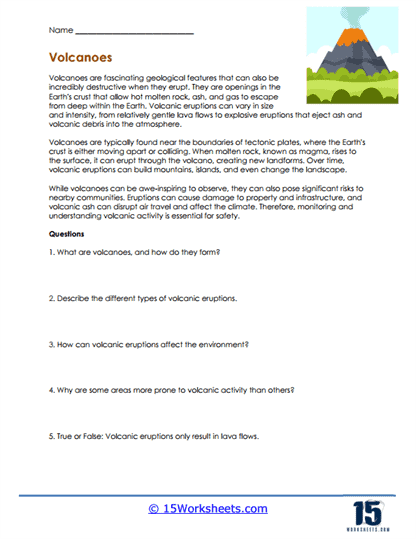Volcanoes

Worksheet Description
The worksheet jumps into the captivating realm of volcanoes, geological structures notorious for their potential destructive power. It sheds light on their formation, which results from openings in the Earth’s crust that allow molten rock, ash, and gas to escape. Furthermore, the material elaborates on the different types of volcanic eruptions, ranging from placid lava flows to explosive events that dispel ash and debris into the atmosphere. The worksheet also touches on the positioning of volcanoes near tectonic plate boundaries and underscores the profound implications of volcanic eruptions on communities, landscapes, and even the global climate.
To effectively engage with this worksheet, students should begin by meticulously reading the provided content to gain a comprehensive understanding of volcanoes and their varied eruption types. The accompanying illustration serves as a visual aid, offering a glimpse into a volcano’s structure and eruption process. After internalizing the information, students should tackle the accompanying questions, referencing the main content to corroborate their answers. Engaging in group discussions or referring to supplemental materials on volcanology can further reinforce their grasp on the subject matter.
This worksheet aspires to impart a comprehensive understanding of volcanoes to its readers. By elucidating the process of their formation, diverse eruption types, and their positioning in relation to tectonic plates, the material provides an encompassing perspective on this geological phenomenon. Additionally, it highlights the significant ramifications of volcanic activity on human settlements, infrastructure, and the broader environment. Through the curated questions, students are prompted to reflect on and solidify their knowledge, ensuring they comprehend the multifaceted nature of volcanoes and their overarching influence on the planet.
